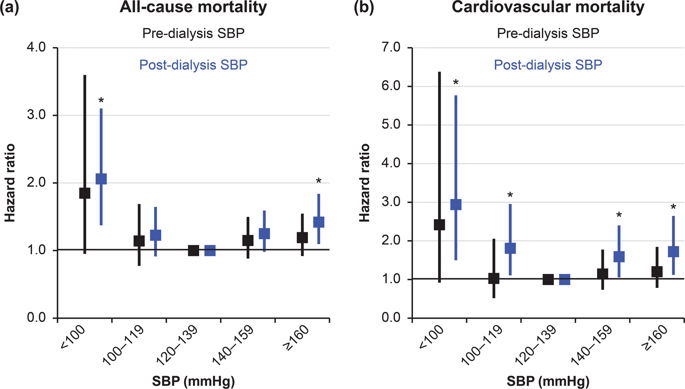当前位置:
X-MOL 学术
›
Hypertens. Res.
›
论文详情
Our official English website, www.x-mol.net, welcomes your
feedback! (Note: you will need to create a separate account there.)
Postdialysis blood pressure is a better predictor of mortality than predialysis blood pressure in Japanese hemodialysis patients: the Japan Dialysis Outcomes and Practice Patterns Study
Hypertension Research ( IF 4.3 ) Pub Date : 2020-03-19 , DOI: 10.1038/s41440-020-0425-1 Kazuhiko Tsuruya 1 , Eiichiro Kanda 2 , Takanobu Nomura 3 , Kunitoshi Iseki 4 , Hideki Hirakata 5
Hypertension Research ( IF 4.3 ) Pub Date : 2020-03-19 , DOI: 10.1038/s41440-020-0425-1 Kazuhiko Tsuruya 1 , Eiichiro Kanda 2 , Takanobu Nomura 3 , Kunitoshi Iseki 4 , Hideki Hirakata 5
Affiliation

|
Blood pressure (BP) is reportedly a predictor of mortality in hemodialysis (HD) patients; however, it is unclear whether pre- or postdialysis BP has greater predictive power. To evaluate the association of pre- and postdialysis BP with patient survival in Japanese HD patients, we enrolled the entire phase 3 and 4 Japan Dialysis Outcomes and Practice Patterns Study populations. Among 3176 patients, 486 were excluded because of missing data. The remaining 2690 patients were divided into five groups according to pre- or postdialysis systolic BP (SBP): <100, 100–119, 120–139, 140–159, and ≥160 mmHg; diastolic BP (DBP): <60, 60–79, 80–89, 90–99, and ≥100 mmHg; or pulse pressure (PP): <50, 50–59, 60–69, 70–79, and ≥80 mmHg. The hazard ratios for all-cause and cardiovascular mortalities were estimated according to pre- and postdialysis SBP, DBP, and PP using a Cox proportional hazards model. During the follow-up period, 495 and 193 subjects died because of any cause and cardiovascular disease (CVD), respectively. In the multivariable-adjusted Cox proportional hazards model, U-shaped associations of postdialysis SBP and PP with mortality rates were observed, but no significant associations were observed with predialysis SBP or PP. A stratified analysis showed significant interactions between history of CVD and postdialysis SBP with all-cause and cardiovascular mortality. Compared with predialysis values, postdialysis SBP and PP are better predictors of all-cause and cardiovascular mortality, showing U-shaped associations with these outcomes in Japanese HD patients.
中文翻译:

日本血液透析患者的透析后血压比透析前血压更能预测死亡率:日本透析结果和实践模式研究
据报道,血压 (BP) 是血液透析 (HD) 患者死亡率的预测指标;然而,尚不清楚透析前或透析后血压是否具有更大的预测能力。为了评估日本 HD 患者透析前和透析后 BP 与患者存活率的关联,我们招募了整个 3 期和 4 期日本透析结果和实践模式研究人群。在 3176 名患者中,486 名因数据缺失而被排除在外。其余 2690 名患者根据透析前或透析后的收缩压 (SBP) 分为五组:<100、100-119、120-139、140-159 和 ≥160 mmHg;舒张压 (DBP):<60、60-79、80-89、90-99 和 ≥100 mmHg;或脉压 (PP):<50、50-59、60-69、70-79 和 ≥80 mmHg。根据透析前和透析后的 SBP、DBP、和 PP 使用 Cox 比例风险模型。在随访期间,分别有 495 和 193 名受试者因任何原因和心血管疾病 (CVD) 死亡。在多变量调整的 Cox 比例风险模型中,观察到透析后 SBP 和 PP 与死亡率的 U 形关联,但未观察到与透析前 SBP 或 PP 的显着关联。分层分析显示 CVD 病史和透析后 SBP 与全因死亡率和心血管死亡率之间存在显着的相互作用。与透析前值相比,透析后 SBP 和 PP 是全因死亡率和心血管死亡率的更好预测指标,在日本 HD 患者中显示出与这些结果的 U 型关联。分别有 495 和 193 名受试者死于任何原因和心血管疾病 (CVD)。在多变量调整的 Cox 比例风险模型中,观察到透析后 SBP 和 PP 与死亡率的 U 形关联,但未观察到与透析前 SBP 或 PP 的显着关联。分层分析显示 CVD 病史和透析后 SBP 与全因死亡率和心血管死亡率之间存在显着的相互作用。与透析前值相比,透析后 SBP 和 PP 是全因死亡率和心血管死亡率的更好预测指标,在日本 HD 患者中显示出与这些结果的 U 型关联。分别有 495 和 193 名受试者死于任何原因和心血管疾病 (CVD)。在多变量调整的 Cox 比例风险模型中,观察到透析后 SBP 和 PP 与死亡率的 U 形关联,但未观察到与透析前 SBP 或 PP 的显着关联。分层分析显示 CVD 病史和透析后 SBP 与全因死亡率和心血管死亡率之间存在显着的相互作用。与透析前值相比,透析后 SBP 和 PP 是全因死亡率和心血管死亡率的更好预测指标,在日本 HD 患者中显示出与这些结果的 U 型关联。但未观察到与透析前 SBP 或 PP 的显着关联。分层分析显示 CVD 病史和透析后 SBP 与全因死亡率和心血管死亡率之间存在显着的相互作用。与透析前值相比,透析后 SBP 和 PP 是全因死亡率和心血管死亡率的更好预测指标,在日本 HD 患者中显示出与这些结果的 U 型关联。但未观察到与透析前 SBP 或 PP 的显着关联。分层分析显示 CVD 病史和透析后 SBP 与全因死亡率和心血管死亡率之间存在显着的相互作用。与透析前值相比,透析后 SBP 和 PP 是全因死亡率和心血管死亡率的更好预测指标,在日本 HD 患者中显示出与这些结果的 U 型关联。
更新日期:2020-03-19
中文翻译:

日本血液透析患者的透析后血压比透析前血压更能预测死亡率:日本透析结果和实践模式研究
据报道,血压 (BP) 是血液透析 (HD) 患者死亡率的预测指标;然而,尚不清楚透析前或透析后血压是否具有更大的预测能力。为了评估日本 HD 患者透析前和透析后 BP 与患者存活率的关联,我们招募了整个 3 期和 4 期日本透析结果和实践模式研究人群。在 3176 名患者中,486 名因数据缺失而被排除在外。其余 2690 名患者根据透析前或透析后的收缩压 (SBP) 分为五组:<100、100-119、120-139、140-159 和 ≥160 mmHg;舒张压 (DBP):<60、60-79、80-89、90-99 和 ≥100 mmHg;或脉压 (PP):<50、50-59、60-69、70-79 和 ≥80 mmHg。根据透析前和透析后的 SBP、DBP、和 PP 使用 Cox 比例风险模型。在随访期间,分别有 495 和 193 名受试者因任何原因和心血管疾病 (CVD) 死亡。在多变量调整的 Cox 比例风险模型中,观察到透析后 SBP 和 PP 与死亡率的 U 形关联,但未观察到与透析前 SBP 或 PP 的显着关联。分层分析显示 CVD 病史和透析后 SBP 与全因死亡率和心血管死亡率之间存在显着的相互作用。与透析前值相比,透析后 SBP 和 PP 是全因死亡率和心血管死亡率的更好预测指标,在日本 HD 患者中显示出与这些结果的 U 型关联。分别有 495 和 193 名受试者死于任何原因和心血管疾病 (CVD)。在多变量调整的 Cox 比例风险模型中,观察到透析后 SBP 和 PP 与死亡率的 U 形关联,但未观察到与透析前 SBP 或 PP 的显着关联。分层分析显示 CVD 病史和透析后 SBP 与全因死亡率和心血管死亡率之间存在显着的相互作用。与透析前值相比,透析后 SBP 和 PP 是全因死亡率和心血管死亡率的更好预测指标,在日本 HD 患者中显示出与这些结果的 U 型关联。分别有 495 和 193 名受试者死于任何原因和心血管疾病 (CVD)。在多变量调整的 Cox 比例风险模型中,观察到透析后 SBP 和 PP 与死亡率的 U 形关联,但未观察到与透析前 SBP 或 PP 的显着关联。分层分析显示 CVD 病史和透析后 SBP 与全因死亡率和心血管死亡率之间存在显着的相互作用。与透析前值相比,透析后 SBP 和 PP 是全因死亡率和心血管死亡率的更好预测指标,在日本 HD 患者中显示出与这些结果的 U 型关联。但未观察到与透析前 SBP 或 PP 的显着关联。分层分析显示 CVD 病史和透析后 SBP 与全因死亡率和心血管死亡率之间存在显着的相互作用。与透析前值相比,透析后 SBP 和 PP 是全因死亡率和心血管死亡率的更好预测指标,在日本 HD 患者中显示出与这些结果的 U 型关联。但未观察到与透析前 SBP 或 PP 的显着关联。分层分析显示 CVD 病史和透析后 SBP 与全因死亡率和心血管死亡率之间存在显着的相互作用。与透析前值相比,透析后 SBP 和 PP 是全因死亡率和心血管死亡率的更好预测指标,在日本 HD 患者中显示出与这些结果的 U 型关联。











































 京公网安备 11010802027423号
京公网安备 11010802027423号